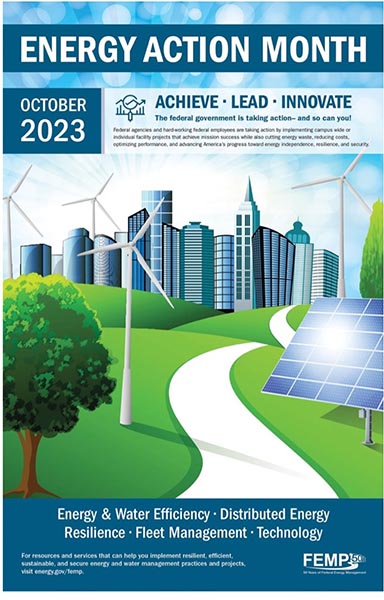Did you know that October is Energy Awareness Month? This month is set aside to bring awareness to “everything energy,” from its importance in our economy to the many ways we can conserve it to why it’s important to do so.
In our industry, we tend to focus on the production side of the business, but we can make gains on the administrative side, as well. Let’s not forget about the little things we can do every day—large or seemingly small—that can make a huge difference over time.

Here are some suggestions made by FEMA:
- Replace incandescent lights with CFLs or LEDs.
While we might take for granted that most of us have done this, have we? While there is a phaseout of incandescent lightbulbs in progress, there are still businesses milking the old ones. It’s time to let them go!
Say an office building currently operates with 500 incandescent light bulbs, each consuming 60 watts of electricity. By replacing these bulbs with CFLs of equivalent brightness, each consuming 14 watts, the office can achieve substantial energy savings:
Energy saved per bulb = (60 watts - 14 watts) = 46 watts
Total energy saved for 500 bulbs = 500 bulbs x 46 watts = 23,000 watts or 23 kilowatts
Assuming the lights are on for an average of 10 hours per day, the daily energy savings would be 23 kw x 10 hours = 230 kWh.
Over the course of a year, the annual energy savings would amount to 230 kWh x 365 days = 83,950 kWh.

Image created by the author using Imagine.ai
Now, assuming the carbon footprint per kWh of electricity is 0.6 pounds, the reduction in the office's carbon footprint from the use of CFLs would amount to 83,950 kWh x 0.6 pounds/kWh = 50,370 pounds.
- Use dimmers, motion sensors, or occupancy sensors to automatically turn off lighting when not in use.
As in the previous example, small changes can have huge impacts when seen in aggregate. Suppose the office consists of a medium-sized conference room that is frequently used for meetings and presentations.
Before the implementation of motion sensors and occupancy sensors, the conference room's lighting system remains illuminated throughout the workday, even when the room is unoccupied. The lighting setup comprises 20 LED bulbs, each consuming 10 watts of electricity.
Now let's consider that the office space that incorporates motion sensors and occupancy sensors to control the lighting based on room activity. When there is activity in the room, the lights go on. When the activity stops, the lights turn off.
Assuming the conference room is used for an average of five hours per day, the energy savings from the motion sensors and occupancy sensors can be calculated as follows:
Energy saved per bulb per hour = 10 watts (when off)
Energy saved per bulb for 5 hours = 10 watts x 5 hours = 50 watt-hours or 0.05 kWh
Total energy saved for 20 bulbs = 20 bulbs x 0.05 kWh = 1 kWh
Over the course of a year, the annual energy savings would amount to 1 kWh x 365 days = 365 kWh.
Considering the carbon footprint per kWh of electricity is 0.6 pounds, the reduction in the office's carbon footprint due to the implementation of motion sensors and occupancy sensors can be calculated:
Carbon footprint reduction = 365 kWh x 0.6 pounds/kWh = 219 pounds
Consider similar steps, such as turning off lights when you leave at night; turning off lights near windows and using natural lighting when possible; and using task lighting rather than lighting an entire room. Each change may not seem like much individually, but in aggregate, the cumulative effect can be significant.
- Choose energy-efficient products and energy-saving technologies for the office (such as those with the Energy Star rating).
Suppose the office is in the process of upgrading its computer systems and office equipment to Energy Star-certified models, including computers, monitors, printers, and heating, ventilation, and air conditioning (HVAC) systems. After the upgrade, the office's energy consumption is reduced by 15%.

Image created by the author using Wonder.ai
Suppose the office previously consumed 100,000 kWh of electricity annually. Considering the carbon footprint per kWh of electricity is 0.6 pounds, the reduction in the office's carbon footprint resulting from the adoption of Energy Star-rated products can be calculated:
Carbon footprint reduction = 15,000 kWh x 0.6 pounds/kWh = 9,000 pounds.
- Close or open window blinds to achieve a more stable indoor temperature.
This may seem like a small thing, but by making this simple change, your office achieves a more stable indoor temperature, thereby decreasing the workload of the cooling system and minimizing energy consumption.
For example,
- Close or adjust window blinds to block direct sunlight to reduce cooling needs during warm months.
- Open window blinds to allow sunlight to naturally heat your workspace during winter months.
- At night, close the blinds to reduce heat loss.
How much difference can this make? Suppose the office previously consumed 10,000 kWh of electricity during the summer months due to heightened cooling demands. With the implementation of the window blinds adjustment strategy, the energy consumption now decreases by 15%, resulting in an annual energy savings of 1,500 kWh.
Considering the carbon footprint per kWh of electricity is 0.6 pounds, the reduction in the office's carbon footprint can be calculated:
Carbon footprint reduction = 1,500 kWh x 0.6 pounds/kWh = 900 pounds
- Replace desktop computers with thin clients or notebook computers and docking stations.
Thin clients and notebooks consume significantly less energy to run than traditional desktop computers. Say the office previously consumed 50,000 kWh of electricity annually due to desktop computer usage. With the implementation of thin clients or notebook computers and docking stations, the energy consumption now decreases by 30%, resulting in an annual energy savings of 15,000 kWh.
And the List Goes On…
These are five examples, but FEMA’s list goes on:
- Unplug equipment that drains energy when not in use (i.e. cell phone chargers, fans, coffeemakers, desktop printers, radios, etc.).
- Use LED or liquid crystal display (LCD) monitors.
- Turn off your computer and monitors at the end of the workday, if possible. If you leave your desk for an extended time, turn off your monitor.
- Use copiers with a low standby feature. Purchase printers and fax machines with a power management feature (and use it).
- Coordinate with vending machine vendor to turn off advertising lights.
- Install programmable thermostats.
- Check furnace ducts for disconnects or leaks. Ensure ductwork is well insulated.
- Insulate water heater, hot water piping, and tanks to reduce heat loss.
- Install low-flow toilets, urinals, faucets, and shower heads.
- Verify the energy management system switches into setback mode during unoccupied hours.
- Install meters to track energy use.

Image created by the author using Wonder.ai
Every one of these steps may seem small individually, but in aggregate, they can make a huge difference. That’s for just one print shop. There are currently just under 37,000 commercial print shops in the United States. Imagine if every one of these shops took the same steps!
We would truly be on the road to a more sustainable future.















Discussion
Only verified members can comment.